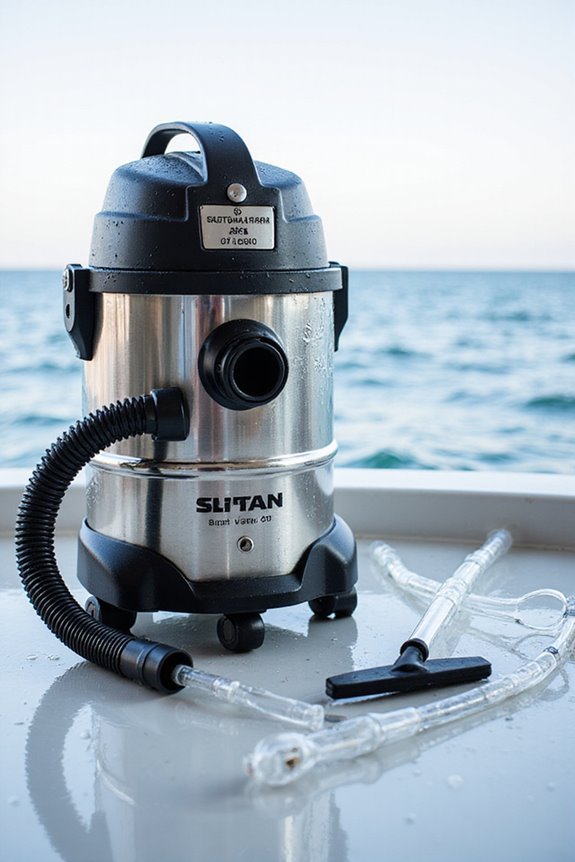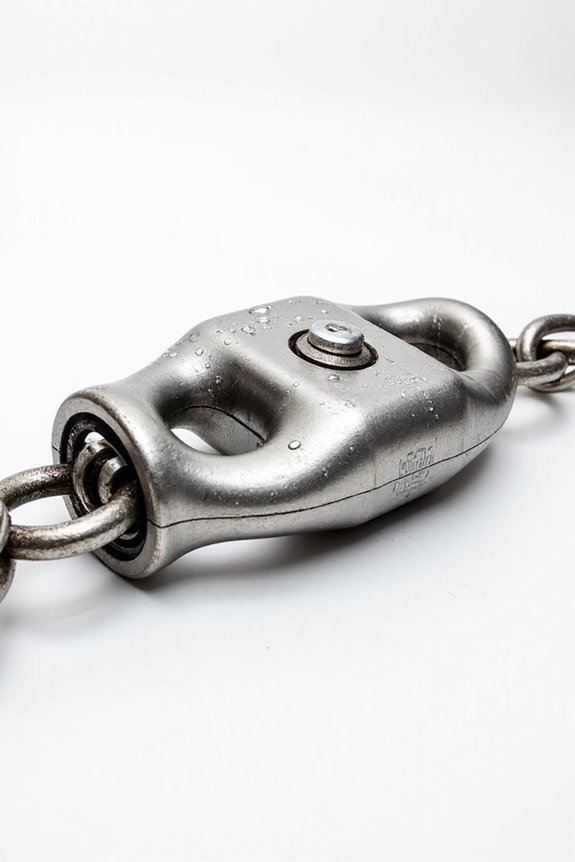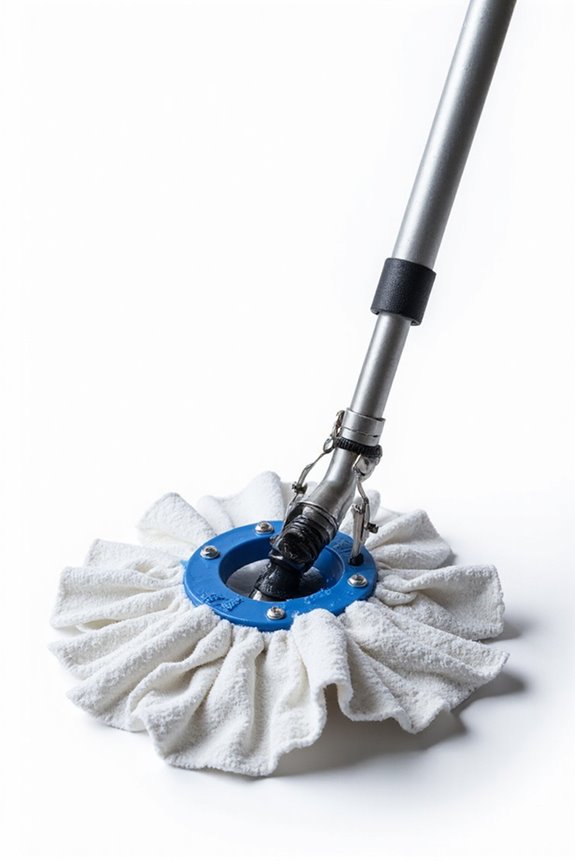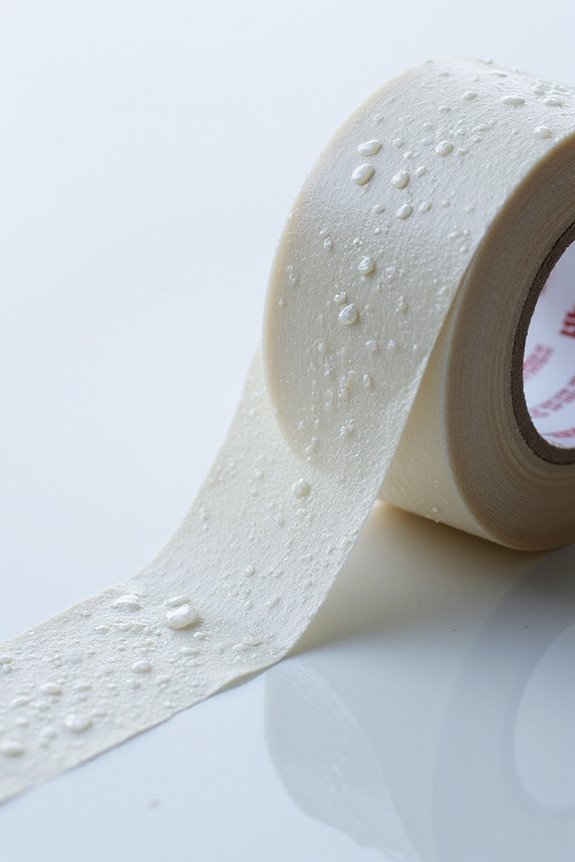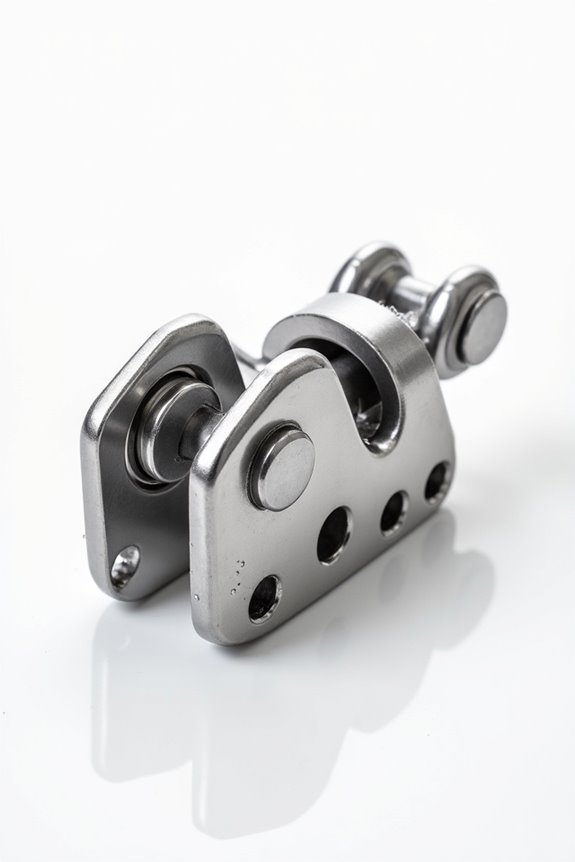Looking for the best wet dry boat vacuum for your yacht? We get it—cleaning up sand, spills, and saltwater messes means choosing a model with strong suction (around 94 CFM), good filters to trap allergens, and the right balance between cordless convenience and corded power. Compact, lightweight options work great in tight spaces, especially with handy accessories. Curious about top brands, battery life, or storage tips to keep your vacuum ready? Stick with us for the full scoop.
Key Takeaways
- Choose vacuums with strong airflow (~94 CFM) and efficient filtration to handle sand, spills, and allergens in yacht interiors.
- Corded models offer steady power for larger yachts; cordless units provide lightweight, flexible cleaning for smaller boats.
- Opt for compact, lightweight vacuums with motor-in-filter designs and foldable handles to save space and improve maneuverability.
- Use marine-grade hose accessories and specialty tools like scrapers and microfiber towels for thorough boat cleaning.
- Maintain your wet dry vacuum with regular filter checks, drum washing, and proper dry storage to ensure longevity and peak performance.
Top Features to Look for in Wet Dry Boat Vacuums
When you’re hunting for a wet dry boat vacuum, it’s easy to get overwhelmed by specs and features, but don’t worry—we’re here to navigate through the essentials together. One vital aspect is vacuum airflow; a motor pushing around 94 CFM guarantees strong suction power so you can tackle everything from sand to spilled water. But what’s power without proper filter maintenance? Look for vacuums with removable cloth filters and synthetic bags—they catch dust and wet debris efficiently, and are simple to swap out, saving you hassle during cleaning. A well-designed filter system also keeps allergens out, which is a blessing in close yacht interiors. So, with the right airflow and smart filtration, your cleaning sessions get efficient and less messy. Ready to explore more yacht-cleaning wisdom?
Benefits of Cordless vs. Corded Vacuums on Yachts
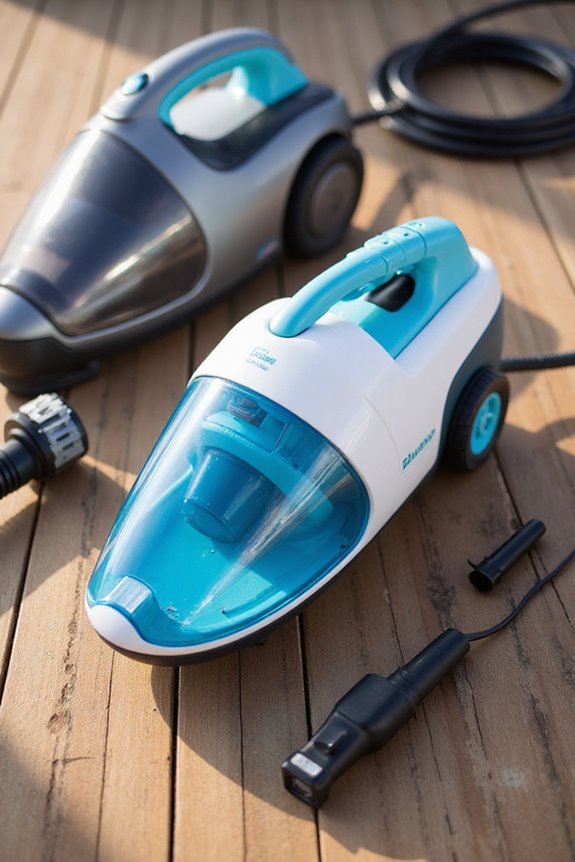
Choosing the right wet dry vacuum for your yacht isn’t just about airflow and filters; it also depends a lot on how you power the device. When we look at vacuum performance comparison, corded models offer consistent, strong suction perfect for larger yachts and extended jobs. They’re reliable without worrying about battery life, which makes them a favorite among those who prioritize power over portability. But what about cordless? They shine in yacht cleaning preferences that favor quick, flexible cleanups—lightweight, easy to maneuver, and great for tight spots. Plus, cordless vacuums like the Dyson Car+Boat give you about 50 minutes of run time—enough for most sessions. So, it really boils down to your yacht size and how you clean. Do you want freedom from cords or steady power? Both have their perks!
Compact and Lightweight Models Perfect for Small Boats
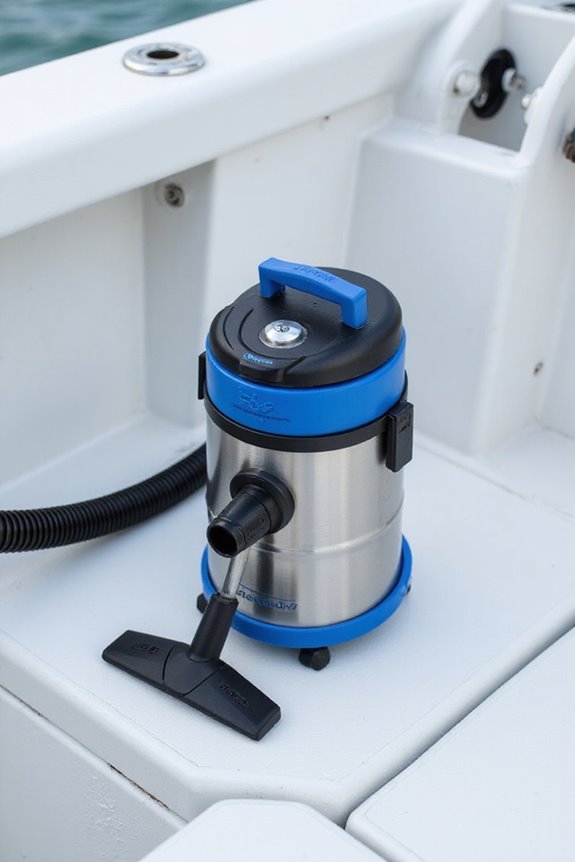
Although space can be tight on small boats, finding a vacuum that’s both compact and powerful doesn’t have to be a hassle. We’ve found that compact models with motor-in-filter technology are game changers—they fit snugly in lockers without hogging space. Plus, lightweight designs under 3 pounds make cleaning a breeze, letting us easily navigate tight yacht cabins without arm cramps. Many even feature foldable handles and built-in hose storage, so clutter stays at bay. Battery-powered options are a win too, giving us cordless freedom to chase dust bunnies anywhere onboard. With cyclonic suction keeping power steady, these vacuums tackle both wet spills and dry crumbs without fuss. So, if you’re after tidy, hassle-free cleaning that respects your boat’s cozy quarters, these models are definitely worth considering.
Essential Accessory Tools for Thorough Boat Cleaning

Since keeping a boat spotless means tackling every nook, we can’t overlook the right accessory tools that make cleaning less of a chore and more of a quick win. When it comes to marine maintenance, choosing the right cleaning accessories—like marine hoses with corrosion-resistant nozzles—ensures durability, especially against saltwater’s wrath. Ever tried cleaning tight corners? Small, high-suction vacuums and long, slim nozzles are lifesavers here. And what about scrapers and brushes? They help us tackle barnacles and stubborn grime without turning the job into an Olympic sport. Let’s not forget drying tools; microfiber towels and shammys work wonders, absorbing water quickly and resisting mildew. With these trusty helpers in hand, we’re set to keep our boats gleaming, ready for any adventure, no sweat involved.
Brand Spotlights: Eureka, Bissell, Black+Decker, and More
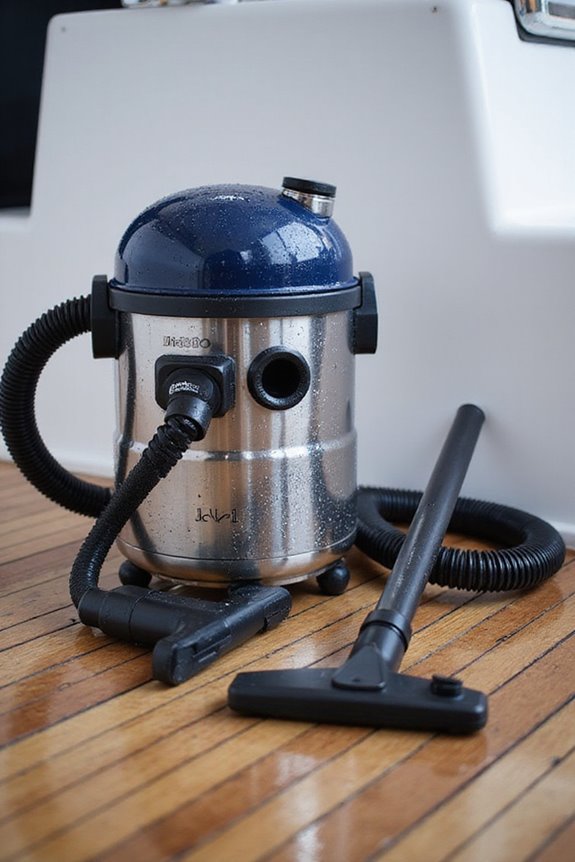
After lining up the right tools to attack every corner of your boat, it’s time to talk about the heavy hitters—the vacuums themselves. We’d say Eureka efficiency stands out for budget-friendly, powerful cleaning with great reach, thanks to its long cord. Bissell versatility is a winner, switching from stick to handheld effortlessly—perfect for tricky spots. If you want Black+Decker portability, their lightweight cordless models make quick cleanups a breeze around tight spaces. Then there’s DeWalt durability, tough and wet-dry ready, though a bit loud. Need peace and quiet? Makita quietness fits the bill, although it’s best for dry operations. So, whether you prefer tried-and-true strength or a nimble sidekick, these brands have your yacht covered. What’s your pick for your next boat cleanup?
Maintaining Your Wet Dry Vacuum for Long-Term Use
When we want our wet dry vacuum cleaners to stick around for the long haul, regular maintenance isn’t just a nice-to-have—it’s a must. Have you ever skipped cleaning frequency checks only to regret a clogged hose or a tired filter? We feel you. Emptying and washing the drum, wiping down the exterior, and storing your vacuum in a dry spot all protect its materials from wear and mildew. Don’t forget the filter—clean it often and swap it out according to the replacement schedule. Inspect hoses and accessories for cracks or clogs; a little care here boosts suction and prevents frustrating breakdowns. Think of it as giving your vacuum a boat-friendly spa day, keeping it ready for action whenever you need it. Staying on top of these steps pays off every time.
Battery Life and Charging Options for Cordless Models
Keeping your wet dry vacuum in top shape involves more than just cleaning and storage—it also means paying attention to how your cordless models handle power. We all value battery longevity, right? Dyson’s handheld offers up to 50 minutes per charge, while Milwaukee’s M18 shares batteries with other tools, boosting charging efficiency and convenience. Swappable batteries—like Dyson’s—mean less downtime, which is great when you’re racing a spill. Onboard, cordless freedom is a must, but don’t forget smart chargers; those Black & Decker batteries need gentle care to keep their lifespan intact. Multi-voltage chargers with maintenance modes can really help extend battery life. And yes, while some models skimp on ergonomics, managing your vacuum’s power setup wisely keeps your cleaning smooth and uninterrupted—just the way we like it.
Cleaning Wet Spills and Dry Debris Effectively on Board
Though boat cleaning often feels like a never-ending chore, having the right wet/dry vacuum makes tackling both wet spills and dry debris way more manageable. When it comes to wet spill management, these vacuums excel at quickly extracting water, diesel spills, or bilge moisture that mops just can’t handle. And you know, reducing leftover dampness helps prevent mold and slippery decks — a definite win for safety and hygiene. On the flip side, dry debris handling is just as vital; those stubborn crumbs, sand, and dock dirt don’t stand a chance. Using versatile attachments, we reach those tight spots without awkward contortions. So, whether it’s a wet mess or dry grit, a well-chosen vacuum keeps our yacht shipshape and ready for the next adventure. Who said cleaning can’t be clever?
Budget-Friendly vs. Premium Wet Dry Boat Vacuums
Although we all want the best gear on board, choosing between budget-friendly and premium wet/dry vacuums can feel like steering through tricky waters. When we weigh budget comparisons, budget-friendly models such as the Porter Cable Cordless or Eureka Easy Clean offer great portability and solid performance for light cleaning. But if we’re after strong suction, advanced filtration, and a full suite of attachments, premium options like the Dyson Animal can really pull their weight. Our feature analysis shows that for heavy-duty tasks or longer cleaning sessions, premium vacuums typically deliver better durability and quieter operation. So, do we prioritize cost or capabilities? That depends on your boat size, cleaning habits, and how much elbow grease you’re willing to spare — but both sides have anchors worth dropping!
Tips for Storing Your Boat Vacuum to Maximize Longevity
After we’ve enjoyed the satisfaction of a clean boat with our trusty wet/dry vacuum, what’s next? Proper storage is key to keeping our vacuum in top shape, right? Good storage solutions mean wiping down hoses, emptying the tank completely, and drying electrical parts to fend off mold or corrosion. We want to stow the vacuum in a dry, ventilated spot—preferably off the floor and out of direct sunlight—to protect both materials and electronics. Using silica gel packs can keep moisture at bay, while periodic inspections catch any pests or wear before they become headaches. Regular vacuum maintenance isn’t just for us—our gear deserves a little TLC between uses to extend its lifespan and keep our yacht spotless for seasons ahead.
Frequently Asked Questions
Can Wet Dry Vacuums Prevent Mold Growth on Boats?
They say, “An ounce of prevention is worth a pound of cure.” For mold prevention, wet dry vacuums help remove moisture, but regular vacuum maintenance and addressing humidity are key for keeping our boats mold-free and cozy together.
Are Wet Dry Boat Vacuums Safe to Use Near Marine Electronics?
We recognize marine electronics safety is essential, so we follow vacuum usage guidelines like using sealed, low-EMI models and keeping distance from sensitive gear. Together, we protect our electronics while keeping our boats clean and safe.
How Do Wet Dry Vacuums Handle Saltwater Exposure?
You might be surprised how saltwater resistance challenges wet dry vacuums, but together we can tackle it. With diligent vacuum maintenance, rinsing, and choosing corrosion-resistant parts, we’ll protect our gear and prolong its life on every adventure.
Can These Vacuums Be Used to Clean Fish Tanks or Bait Wells?
We’ve found wet/dry vacuums can help with fish tank maintenance and bait well cleaning, but they need careful monitoring and prep. Let’s remember, specialized tools often work better and keep our aquatic friends safer.
What Is the Typical Warranty Coverage for Boat-Specific Wet Dry Vacuums?
Did you know some warranties last up to 10 years? We find typical warranty duration covers defects, ensuring product reliability. Together, we can trust these vacuums to perform well, as long as we follow care guidelines and usage limits.

